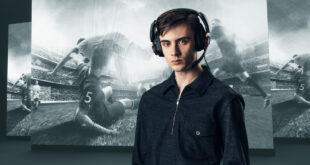Game:
Dead to Rights: Retribution
Developer:
Volatile Games
Publisher:
Namco Bandai Games
Audio Team:
Audio manager/composer: Matt Black
Lead audio designer: Richard Blackley
Dead to Rights: Retribution is a Noir-ish ground-up reinvention of the classic franchise in which you experience the origins of vice cop Jack Slate and his faithful, albeit deadly, canine sidekick. There’s fighting a-plenty with ‘seamlessly integrated combat’ allowing you to freely switch between gunplay, brawling and use of your AI mutt, Shadow.
Audio-wise, it’s quite simply the largest production undertaken by Mssrs Black and Blackley – in scope of content, size of team, supporting technology and budget, featuring as it does a cast of actors recorded in LA and a one-and-a-half hour music score, the orchestral aspects of which were laid down at the legendary Abbey Road Studios.
With the immensity of the task before them, the team chose to integrate the FMOD audio engine with extensive in-house world editor code. Sounds could be positioned in real-time while game-connected and relevant replay and DSP parameters tweaked with immediate in-game auditioning. Explains Blackley: “You don’t really know if something works until you hear it in context so implementing sound live in the game really upped our productivity, and we were able to mix as we went along. We’re using a lot of run-time DSP for environmental FX and also for creative FX like when the player’s taking damage (we pretty much filter out everything).
“We have a system where a sound emitter can duck another sound emitter to create space (which works really well to say ‘duck a helicopter when you’re in a tunnel’) and also a priority system for gunfights – when there’s a lot of the same weapons being fired, it will cull foley and footsteps – less important quiet sounds which you won’t miss – in favour of focusing on the guns with more clarity. I monitor in both surround and stereo on a Genelec setup – it’s really important to ‘QA’ your own work throughout development.”
Regarding the huge music composition task, Black is candid: “The scale of it was a bit daunting which is why I’m really pleased that overall, it holds together with consistency as a body of music throughout all the various character themes which players subliminally link with specific enemies.
“I started by talking to our publisher about music style and we compared notes using reference materials, which are vital, as not everyone shares the same language and terminology when discussing music. I made demos of key themes polishing them to a high standard ready for review and sign-off following which I fleshed out those themic directions making them into the actual pieces that would feature in the game.
“Then we set about the live recording. It was quite a challenging process but once you’ve established the area stylistically you want to work within and benchmarked the things you’re aiming for musically, you get into a groove and it all starts to flow.”
Strings and brass for 20 compositions were recorded at Abbey Road Studios during 12-hours of sessions but a smart approach and individual instrument mic-ing meant Black was subsequently able to re-purpose the resultant stems for further pieces with relative flexibility.
Back at base, he runs Cubase (with FX Teleport on a separate machine) leaning heavily on Quantum Leap instrument sets in combination with Stylus, Absynth soft synths as well as a Moog Voyager and Nord Lead 3, not to mention a Kaoss Pad into which he mashes and manipulates self-produced guitar loops.
All well and good, but the really great and notable thing that emerges in conversation with these guys is their thoughtful, careful and intelligent approach to the end mix. Why? Because in a game where combat is King and the soundscape is flooded with gunfire and helicopters, it’s clear they considered and mitigated the ever-present danger of mix cacophony before a note of music was written or a single sound designed.
“We were determined right from the start to have a clean, uncluttered mix – we just didn’t want the audio to be busy all the time fatiguing the player’s ears. We talked about it a lot,” says Blackley. “It’s great to have a strong dialogue between the composer and sound designer with no egos in the way.”
Adds Black: “There was also some consideration when composing and producing the music – making sure I wasn’t taking up the frequency range with big guitars and drums.”
Wall-to-wall music was ruled out as anathema. Instead, discussion took place about dynamic range, pacing of the audio and leaving space to get bigger with music in some areas whilst leaving ambience to colour others. Says Black: “We believe sound is as capable of story-telling as music and we certainly have that – especially where visuals fade to black and you can’t see what’s happening. The result is that there’s never anywhere in the game where the soundtrack’s too in-your-face or too crowded even though it’s obviously action-packed.”
—
John Broomhall is an independent audio director, consultant and content provider.
www.johnbroomhall.co.uk

 MCV/DEVELOP News, events, research and jobs from the games industry
MCV/DEVELOP News, events, research and jobs from the games industry


